The flânerie of an urban walker
DOI:
https://doi.org/10.1590/1806-9584-2020v28n157230Abstract
This article analyzes the interaction between Alice, from Quarenta dias – a novel by Maria Valéria Rezende (2014b) –, and the city of Porto Alegre, in which she wanders like a contemporary flâneuse. The character, in fact, calls herself an urban walker, since she gradually becomes an inhabitant of the streets. The viability of a character such as a female flâneuse is discussed based on the writings of Janet Wolff (1985), Griselda Pollock (1988) and Lauren Elkin (2016). According to Elkin (2016), invisibility is a fundamental characteristic for someone to perform the flânerie, which would be unfeasible for a woman, who is always the object of male gaze on the streets. Alice, however, realizes she is invisible to others, due to her age, her origins and the fact that she becomes a homeless person for forty days. The novel also calls for a series of reflections about contemporary cities and the ways minorities occupy the urban spaces.Downloads
References
ACHUGAR, Hugo. “Culpas y memorias en las modernidades locales: balbuceos fragmentarios so pretexto de ‘el flâneur’ de Walter Benjamin”. Tonos Digital, n. 16, p. 1-17, 2008. Disponível em http://www.tonosdigital.es/ojs/index.php/tonos/article/view/239/181. Acesso em 26/07/2017. ISSN 1577-6921.
BAUMAN, Zygmunt. Vidas desperdiçadas. Tradução de Carlos Alberto Medeiros. Rio de Janeiro: Zahar, 2005.
BAUMAN, Zygmunt. Confiança e medo na cidade. Tradução de Eliana Aguiar. Rio de Janeiro: Zahar, 2009. (E-book)
BENJAMIN, Walter. “O Flâneur”. In: BENJAMIN, Walter. Obras escolhidas III. Tradução de João Carlos Martins Barbosa e Hemerson Alves Baptista. São Paulo: Brasiliense, 1994. p. 33-65.
BLISS, Robert. 10 Hours of Walking in NYC as a Woman. Nova Iorque, 2014. Disponível em https://www.youtube.com/watch?v=b1XGPvbWn0A. Acesso em 16/11/2017.
BRAIDOTTI, Rosi. “Diferença, diversidade e subjetividade nômade”. Tradução de Roberta Barbosa. Labrys – Estudos Feministas Labrys, Paris, Montreal, Brasília, n. 1-2, p. 1-16, 2002. Disponível em http://www.historiacultural.mpbnet.com.br/feminismo/Diferenca_Diversidade_e_Subjetividade_Nomade.pdf. Acesso em 15/08/2016. ISSN 1676-9651.
CANCLINI, Néstor. “Cidades e cidadãos imaginados pelos meios de comunicação”. Opinião Pública, Campinas, v. 8, n. 1, p. 40-53, mai. 2002. Disponível em http://www.scielo.br/pdf/op/v8n1/14873.pdf. Acesso em 01/06/2019. ISSN 0104-6276. Doi: 10.1590/S0104-62762002000100003.
COMISIÓN INTERAMERICANA DE DERECHOS HUMANOS. Una mirada a la violencia contra personas LGBTI: comunicado à imprensa. Washington, n. 153, 2014. Disponível em http://www.oas.org/es/cidh/lgtbi/docs/Anexo-Registro-Violencia-LGBTI.pdf. Acesso em 16/05/2017.
DALCASTAGNÈ, Regina. “Sombras da cidade: o espaço na narrativa brasileira contemporânea”. Revista Estudos de Literatura Brasileira Contemporânea, Brasília, v. 21, p. 33-53, jan./jul. 2003. Disponível em http://repositorio.unb.br/handle/10482/9619. Acesso em 01/06/2019 Epub 01/01/2003. ISSN 2316-4018.
ELKIN, Lauren. Flâneuse: women walk the city in Paris, New York, Tokyo, Venice and London. New York: Farrar, Straus and Giroux, 2016. (E-book)
FÓRUM BRASILEIRO DE SEGURANÇA PÚBLICA. Visível e invisível: a vitimação de mulheres no Brasil. São Paulo, 2017. Disponível em http://www.forumseguranca.org.br/wp-content/uploads/2017/03/relatorio-pesquisa-vs4.pdf. Acesso em 16/05/2017.
GEORGE, Rosemary. The politics of home: postcolonial relocations and twentieth century fiction. Berkeley: University of California Press, 1996.
HARVEY, David. “A Liberdade da Cidade”. In: HARVEY, David; MARICATO, Ermínia et al. Cidades rebeldes: passe livre e as manifestações que tomaram as ruas do Brasil. São Paulo: Boitempo, 2013. p. 27- 34.
ITO, Carolina. “A cidade ideal das mulheres”. Revista Trip, São Paulo, 2017. Disponível em http://revistatrip.uol.com.br/tpm/arquitetura-e-planejamento-urbano-a-cidade-ideal-das-mulheres. Acesso em 10/05/2017. ISSN 1414-350x.
KOETZ, Vanessa. “Nas ruas e nas praças!”. In: KOETZ, Vanessa; MARQUES, Helena; CERQUEIRA, Jéssica (Orgs.). Direito à cidade: uma visão por gênero. São Paulo: Instituto Brasileiro de Direito Urbanístico, 2017. p. 72-77.
MADARIAGA, Inés. “Urbanismo con perspectiva de género”. Unidad de Igualdad y Género, Andalucía, módulo 4, p. 1-102, 2004. Disponível em https://www.juntadeandalucia.es/institutodelamujer/institutodelamujer/ugen/sites/default/files/documentos/98.pdf. Acesso em 01/06/2019.
MASSEY, Doreen. Space, place and gender. Minneapolis: University of Minnesota Press, 2009.
MULVEY, Laura. “Visual pleasure and narrative cinema”. In: ERENS, Patricia (Ed.). Issues in feminist film criticism. Bloomington: Indiana University Press, 1990. p. 28-40.
PICCINI, Mabel. “Sobre a comunicação nas grandes cidades”. Opinião Pública, Campinas, v. 9, n. 2, p. 1-19, out. 2003. Disponível em https://periodicos.sbu.unicamp.br/ojs/index.php/op/article/view/8641130/8641. Acesso em 26/07/2017. ISSN 0104-6276.
PINHEIRO, Leandro. “As periferias de Porto Alegre: suas pertenças, redes e astúcias. Bases para compreender seus saberes e dinâmicas éticas”. Instituto Humanitas Unisinos, São Leopoldo, 2016. (Entrevista concedida à Patricia Fachin). Disponível em http://www.ihu.unisinos.br/159-noticias/entrevistas/558958-periferias-de-porto-alegre-contingente-populacional-supera-o-de-muitascidades-gauchas-entrevista-especial-com-leandro-pinheiro. Acesso em 16/11/2017.
POLLOCK, Griselda. Vision and difference: femininity and the histories of art. London: Routledge, 1988.
PREFEITURA DE SÃO PAULO. Secretaria Municipal de Desenvolvimento Urbano. “A mobilidade das mulheres na cidade de São Paulo”. In: SPECIE, Priscila; VANETI, Vitor; MOUALLEM, Pedro. Informes urbanos, São Paulo, n. 25, p. 1-7, 2016. Disponível em https://www.prefeitura.sp.gov.br/cidade/secretarias/upload/Informes_Urbanos/INFORME%20MobSPMulher_rev.pdf. Acesso em 20/05/2017.
REZENDE, Maria Valéria. “Maria Valéria Rezende viveu na rua para escrever romance”. Estadão, São Paulo, 2014a. (Entrevista concedida à Maria Fernanda Rodrigues) Disponível em http://cultura.estadao.com.br/noticias/geral, maria-valeria-rezende-viveu-na-rua-para-escreverromance,1161541. Acesso em 23/07/2017.
REZENDE, Maria Valéria. Quarenta dias. Rio de Janeiro: Objetiva, 2014b.
SENNETT, Richard. O declínio do homem público: as tiranias da intimidade. Tradução de Lygia Araújo Watanabe. São Paulo: Companhia das Letras, 1988.
WOLFF, Janet. “The invisible flâneuse: women and the literature of modernity”. Theory, Culture & Society, v. 2, n. 3, p. 34-50, 1985.
WOOD, James. Como funciona a ficção. Tradução de Denise Bottmann. São Paulo: Cosac Naify, 2012.
WOOLF, Virginia. Um teto todo seu. Tradução de Vera Ribeiro. Rio de Janeiro: Nova Fronteira, 1985.
Downloads
Published
How to Cite
Issue
Section
License
Revista Estudos Feministas is under the Creative Commons International 4.0 Attribution License (CC BY 4.0), that allows sharing the work with recognition of authorship and initial publication in this journal.
The license allows:
Sharing (copying and redistributing the material in any support or format) and/or adapting (remixing, transforming, and creating from the material) for any purpose, even if commercial.
The licensor cannot revoke these rights provided the terms of the license are respected. The terms are the following:
Attribution – you should give the appropriate credit, provide a link to the license and indicate if changes were made. This can be done in several ways without suggesting that the licensor has approved of the use.
Without additional restrictions – You cannot apply legal terms or technological measures that prevent others from doing something allowed by the license.




